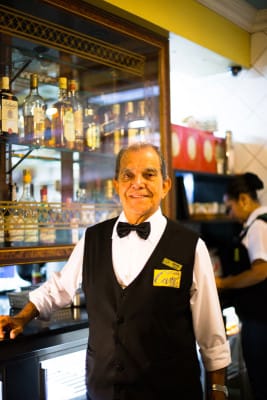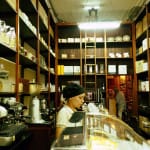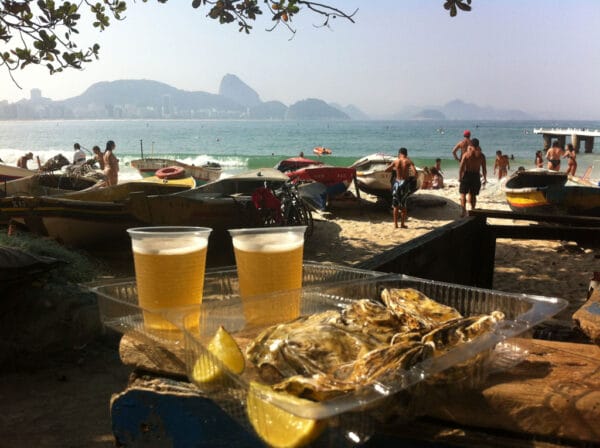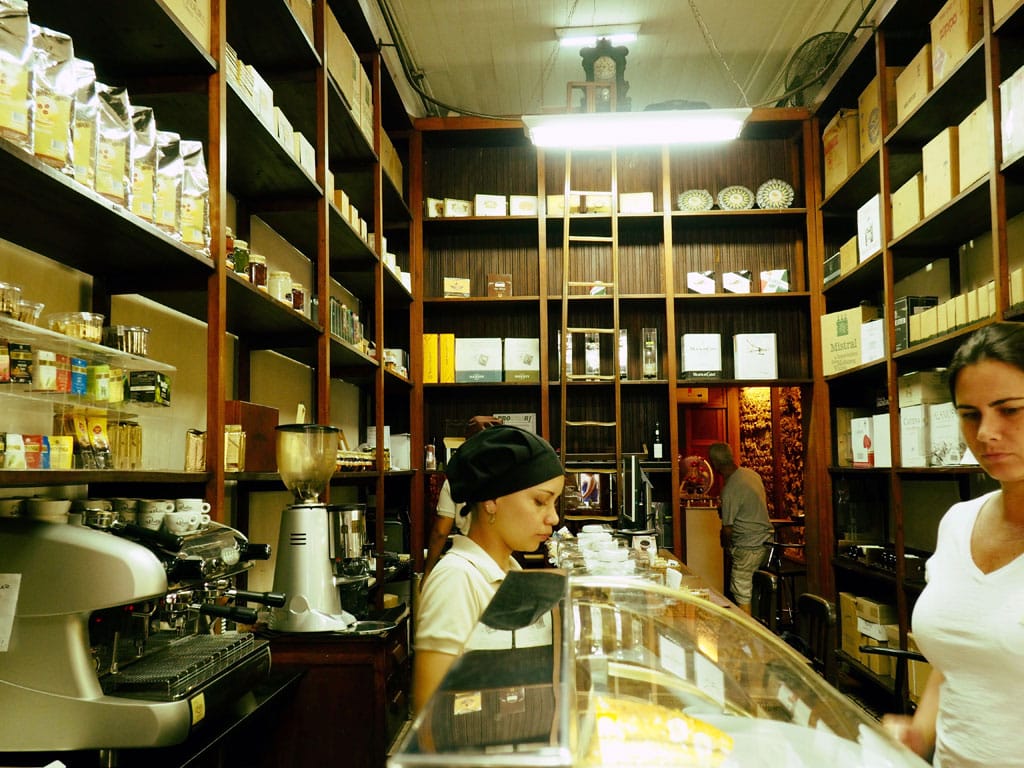The popular saying that Rio is known more for its bar culture than for its café culture has serious counter-evidence in the old city. Beginning in 1808, when Portuguese emperor Dom João fled Napoleon and relocated his imperial court to Rio, European architects, businessmen and intellectuals followed him and attempted to show that their society could thrive in a tropical land. Many stayed on after the royal family returned to Portugal in 1822, and over the course of the 19th century filled the old city’s cobblestone streets with neoclassical row houses, Baroque revival churches and a Beaux-Arts theater. Into this mix, Frenchman Charles Cavé founded a bakery in 1860 in a pink Victorian building as frosted in white trim as the pastries it purveyed. The sweets, according to fashions of the time, came largely from the French and Portuguese traditions, and Rio’s political and artistic classes munched on them with coffee and tea.
The oldest still-operating bakery in Rio, Casa Cavé’s interior, exterior and menu remain close to its origins. Most famously, it sells the Portuguese pastel de Belém, also called pastel de nata, a sweet egg custard sitting in a crispy pastry shell and caramelized on top; the tarts were invented in the 1830s by monks at a Lisbon monastery who used egg whites as a low-tech method of starching sheets and got creative with the leftover egg yolks. We recommend asking that the pasteis be warmed in the oven and sprinkled with cinnamon.
A heavenly host of Portuguese pastries with religious names graces Cavé’s shelves, many likewise invented at convents or monasteries: the puff pastry Jesuita (the Jesuit), folded around cream and topped with meringue and chestnuts; the rose-shaped, powdered-sugar-covered and almond-filled pastel de Santa Clara (St. Claire’s cake); the dusted almond cake toucinho do céu (bacon from heaven, a reference to the lard used in the original Portuguese version); the sticky cake papo de anjo (angel’s chins); and the unforgettable barriga de freira (nun’s belly), egg custard with breadcrumbs wrapped in rice-paper casings, such that it resembles a paunch. These sit between sugar-drenched palmiers, lemony girassol cookies and Portuguese versions of the multi-layered French mille-feuille (here called mil-folhas).
 For those who would like a traditional breakfast to accompany rich coffee or the wide variety of teas, we recommend the torrada (toasted loaf bread) topped with white Minas cheese and honey. Juices such as pineapple, orange and the cranberry-like sour acerola from northern Brazil offer fresh side notes to Cavé’s delightful sugar overload. In addition to the pink building crowning the corner of Uruguaiana and Sete de Setembro streets, Cavé has another location two doors down on Uruguaiana, a quiet tea room entered through a pastry-filled hallway. Small but magnificent columns adorn the middle of its dining area, which is ringed by long mirrors set over a row of colorful encaustic cement tiles, typical of Spain, Portugal and many old Rio buildings.
For those who would like a traditional breakfast to accompany rich coffee or the wide variety of teas, we recommend the torrada (toasted loaf bread) topped with white Minas cheese and honey. Juices such as pineapple, orange and the cranberry-like sour acerola from northern Brazil offer fresh side notes to Cavé’s delightful sugar overload. In addition to the pink building crowning the corner of Uruguaiana and Sete de Setembro streets, Cavé has another location two doors down on Uruguaiana, a quiet tea room entered through a pastry-filled hallway. Small but magnificent columns adorn the middle of its dining area, which is ringed by long mirrors set over a row of colorful encaustic cement tiles, typical of Spain, Portugal and many old Rio buildings.
At Cavé’s original location, a different set of tiles blankets the floor, while blue- and purple-flowered glass panels border mirrors on the wall.
At the edge of the room, by a carved 1860s-era wooden chair and Spanish glass-topped table from the same period, a small gold plaque marks where Chiquinha Gonzaga, abolitionist, composer and the first woman to conduct a Brazilian orquestra, dined and debated the issues of the day. Other famous Cavé customers of the past include modernist painter Tarsila do Amaral, anthropologist Darcy Ribeiro and President Juscelino Kubitschek. Poet Carlos Drummond de Andrade “always asked for hot chocolate and pão Petropolis,” or buttered toast, according to Waldir Ramos de Mello. Now 78, de Mello has been on the waitstaff at Cavé for 37 years, watching decades of thinkers powwowing in his tea room.
 January 12, 2017 La Miniatura
January 12, 2017 La Miniatura
Julian Ramírez started out at the age of 14 as a shop boy at a busy bakery in Colonia […] Posted in Mexico City August 1, 2016 Olympian Appetites
August 1, 2016 Olympian Appetites
Athletes, spectators and everyone else gathered in Rio for the Summer Olympics will have […] Posted in Rio May 19, 2016 Charutaria Syria
May 19, 2016 Charutaria Syria
Before thousands of Syrian and Lebanese immigrants arrived in Rio at the beginning of […] Posted in Rio
Published on May 04, 2016
Related stories
January 12, 2017
Mexico CityJulian Ramírez started out at the age of 14 as a shop boy at a busy bakery in Colonia Guerrero in 1959, then a bustling blue-collar neighborhood, easily connected to downtown by streetcar. Back then, at La Antigua del Guerrero, he learned the business: wiping windows, sweeping up and eventually making deliveries on his bike.…
August 1, 2016
RioAthletes, spectators and everyone else gathered in Rio for the Summer Olympics will have no shortage of good eating options – and not just in the usual touristed areas. We’ve rounded up some of our favorite spots around town. CADEG The 100,000-square-meter market is divided into three warehouse-style floors, with a pavilion just for flower…
May 19, 2016
RioBefore thousands of Syrian and Lebanese immigrants arrived in Rio at the beginning of the 20th century, colonists organized the old city according to geography, chance and Spanish and Portuguese planning conventions. This meant stores in the same category – ironware, shoes, musical instruments – were grouped together, sometimes even allotted their own street. If…


















































































